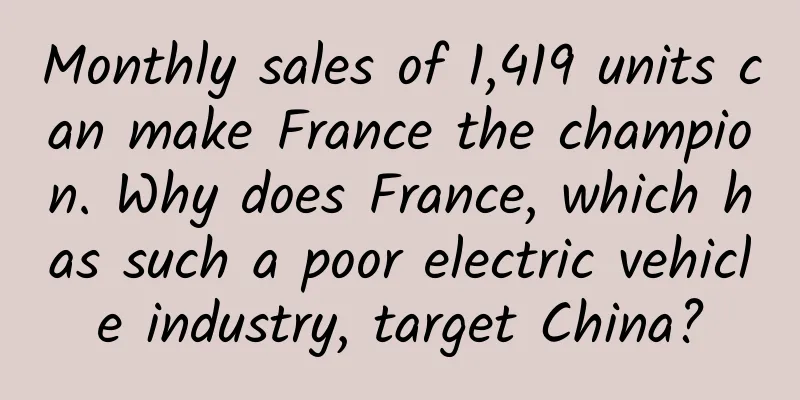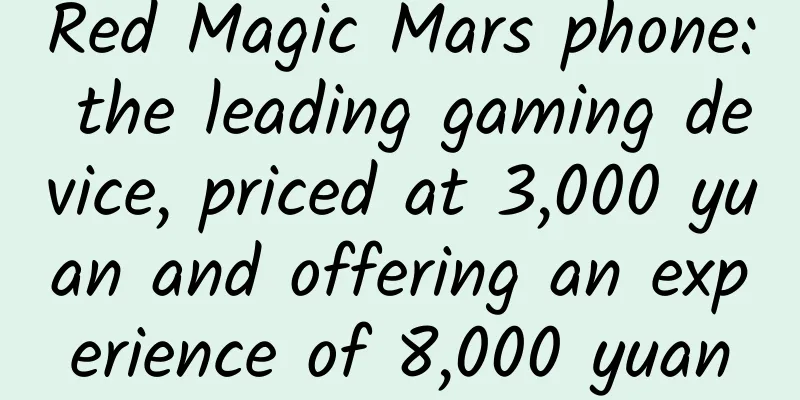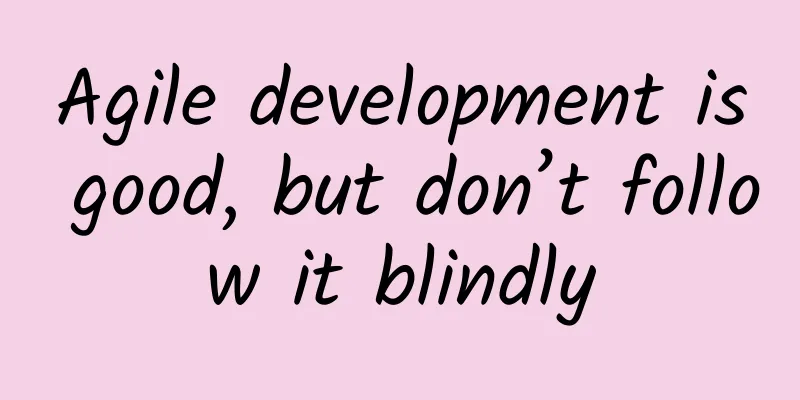Monthly sales of 1,419 units can make France the champion. Why does France, which has such a poor electric vehicle industry, target China?

|
All in all, China's automobile industry has shifted from defense to offense in the past three years or so. Although the time is not long, some Western countries and automobile manufacturers have already begun to spit sour words and create obstacles. While lamenting, they did not talk about fair competition. Instead, they adopted measures such as forcibly imposing tariffs, shyly shaking the fig leaf of trade protectionism. At the end of August this year, the European Commission put forward a draft decision to impose final anti-subsidy duties on pure electric vehicles imported from China. The main driving force behind this draft was France and the automobile companies behind it. Since September 13, 2023, when European Commission President von der Leyen first announced that she would launch an anti-subsidy investigation into Chinese electric vehicles, France has been one of the main promoters. European media reported at the time that France even offered support for von der Leyen's re-election in exchange for Brussels' support for the issue. As one of China's major economic and trade partners in Europe, France has been uncharacteristically jumping up and down on this issue for two main reasons. First, the development of new energy vehicles in France is slow, and the fear of Chinese manufacturers exceeds that of countries such as Germany. France urgently needs trade protection to win time and space for the development of domestic industries. Second, France is not an agricultural country like Spain and is worried that China will "retaliate" with agricultural products such as pork. French cars were once the main force in the Chinese auto market, but they have long been forgotten in the past decade. The three major brands of Citroen, Peugeot and Renault have all retreated, with a market share of only 0.2% in 2024, and this was achieved under the blood-letting promotion of Citroen C6. Judging from the data, the Chinese market has already been lost for French cars. Since they have changed from wearing leather shoes to wearing straw sandals, why not offend China a bit? Moreover, offending China can appease the unemployed auto industry workers in China and win a few votes. Why not? As for how it will end in the future, as their King Louis XV said, after I die, I don't care about the flood. France, once a major automobile power, is ready to go all out on the road of new energy. In 2023, France's new car sales reached 1.774 million units, a year-on-year increase of 16.1%, which is considered a relatively good performance among major European countries. From the perspective of energy structure, France is also a relatively complex automobile market. In July 2024, the sales volume of new cars in France was 126,000, of which pure fuel vehicles accounted for 29.6% and hybrid vehicles accounted for 38.3%; the sales volume of pure electric vehicles reached 17,032, accounting for 13.5%; the sales volume of plug-in hybrid models was 9,174, accounting for 7.2%. If we follow the standards of the Chinese automobile market, only plug-in hybrid and pure electric models are considered new energy vehicles, with a combined penetration rate of 20.8%, roughly equivalent to China's level in 2021. In fact, France's new energy vehicle penetration rate is not far behind other major European automobile countries. The problem is that when the new energy penetration rate reaches about 20%, the overall data should have started to rise and accelerate, but the fact is that France's new energy vehicle penetration rate has dropped from 23.3% last year to 20.8% today. France made the same mistake as Germany on this issue. In January this year, the French government reduced the subsidy for purchasing electric vehicles from 5,000 euros to 4,000 euros, and the 1,000 euro subsidy for purchasing used electric vehicles was also cancelled, which severely hit consumers' purchasing enthusiasm. In July, the best-selling electric car in France was the Renault Megane, an A-class sedan, with monthly sales of 1,419 units; in second place was the Tesla Model Y, with sales of 1,205 units; in third place was the Peugeot e-208, with monthly sales of 1,166 units, totaling 3,790 units. Even if the long tail sales of other brands are included, this number would not be particularly shocking. Overall, the current size of France's new energy market is at most less than 30% of Shanghai's. In June last year alone, 36,688 new energy vehicles were sold in Shanghai. The automobile industry is an industry that pursues economies of scale. In the early days of the development of new energy vehicles, China, the United States and the European Union all chose various forms of government subsidies to support the development of new energy vehicles. Public data shows that the French government's electric vehicle subsidy expenditure in 2023 was 1.7 billion euros, exceeding the original plan of 1.4 billion euros, but the budget was reduced to 1.5 billion euros in 2024. Although the French government did not directly cancel the subsidies like the German government, it also experienced policy swings. Strong industrial support policies are essential in the early stages of new energy vehicle development, and this is true for any country. France wants to develop new energy vehicles on the one hand, but is hesitant due to fiscal budget pressure on the other. The result is predictable. Without huge sales, consumers will not be able to form consumption habits for new energy vehicles. It is hard to believe that a major European country that can win the monthly sales championship with sales of around 1,500 vehicles a month can continue to implement its original new energy policy. Such a bad political and business environment naturally cannot give birth to a complete new energy industry chain. Taking the power battery, the core of new energy vehicles, as an example, Chinese manufacturers currently occupy more than 60% of the global power battery market, and the rest of the market is mainly divided up by Japanese and Korean manufacturers, resulting in the entire European Union having almost no say in power batteries. France has a relatively representative power battery manufacturer - Verkor, a startup battery company established in 2020. So far, it has obtained 3.7 billion euros in financing. Among its investors are financial institutions such as Societe Generale and La Banque Postale, as well as industrial giants such as Schneider Electric. Verkor is so highly valued because it is the "hope of the whole village" in the EU and is a rare manufacturer capable of supplying power batteries to European manufacturers such as Renault. In the eyes of many people in France, Verkor is a key manufacturer for the EU to get rid of its dependence on Chinese power batteries. But the problem is that Verkor hasn't built a single factory yet. In addition, industry insiders generally believe that Verkor does not have much technical accumulation, especially the technological gap between it and Chinese manufacturers is quite large. For example, Verkor expects to put NCM batteries into production in 2025, but Chinese manufacturers have begun to gradually phase out this type of battery and move towards higher-end solid-state batteries. Verkor's products are likely to face the embarrassing dilemma of "falling behind as soon as they are put into production." Verkor is a representative manufacturer in the field of power batteries in France, and it has such a high level, let alone other manufacturers. This alone can show the overall level of the French new energy vehicle industry. France is advocating to impose tariffs on Chinese electric vehicles in order to protect the development of its own new energy vehicles. However, in the absence of market demand, lack of core technology, and wavering industrial policies, can closing the door really protect itself? Faced with this question, the Empress Dowager Cixi, who lived more than a hundred years ago, was actually quite familiar with it. As a winner of Toutiao's Qingyun Plan and Baijiahao's Bai+ Plan, the 2019 Baidu Digital Author of the Year, the Baijiahao's Most Popular Author in the Technology Field, the 2019 Sogou Technology and Culture Author, and the 2021 Baijiahao Quarterly Influential Creator, he has won many awards, including the 2013 Sohu Best Industry Media Person, the 2015 China New Media Entrepreneurship Competition Beijing Third Place, the 2015 Guangmang Experience Award, the 2015 China New Media Entrepreneurship Competition Finals Third Place, and the 2018 Baidu Dynamic Annual Powerful Celebrity. |
>>: When MDR-1ABT meets NW-ZX100, Sony's high-tech technology makes audiophile headphones wireless
Recommend
Analysis of AARRR (user growth) model: How to achieve user growth?
This article starts from the experience and expla...
52 years later, Dongfanghong-1 is still flying in the sky? !
This article was reviewed by Liu Yan, Space Appli...
Cao Yu Back Training Baidu Cloud Download
Cao Yu back training resource introduction: Cours...
Feel like your brain isn't working anymore? Here are 11 brain-boosting foods →
In the pursuit of a healthy life, we are increasi...
How does Google never go down?
According to Google's official data, in 2015,...
In a world that sells privacy, you and I are just products of Apple.
Recently, Apple announced that it has won a paten...
Drinking coffee can not only help you lose weight, but also reduce the risk of death? But many people don’t drink it right…
We feel sleepy in spring, tired in autumn, and na...
A rare spectacle! Over 100 million
Hundreds of millions of eggs develop into adults ...
Meizu Note 6 review: A 1,000-yuan phone that can rival iPhone 7 in terms of camera performance
Without the guest performance at the opening of t...
Are Douyin stores and window displays the same? What are the connections and differences?
This article mainly introduces whether Douyin Stor...
Google launches Android Auto Beta testing program to encourage users to try and submit feedback
Google is launching a new beta program for Androi...
How do brands choose UP hosts on Bilibili for promotion?
Bilibili has special platform attributes. From a ...
Crazy! People who don’t have cats are starting to pick up Hericium erinaceus!
People who want to pet cats but can’t get them ar...
Eating carp, celebrating silkworms...there are so many interesting folk customs on New Year's Day!
New Year's Day is coming. As a Chinese festiv...
AppStore has a loophole and user privacy has been leaked on a large scale
A vulnerability appeared in the AppStore, causing...









